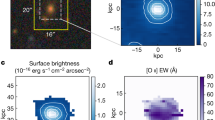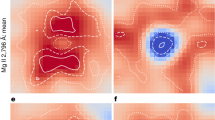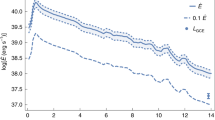Abstract
DETERMINATION of the mean gas concentration in intergalactic space (Nmg) is an important problem which is still far from being solved. One may hope finally to determine the value of Nmg in different indirect ways (see, for example, ref. 1). At the same time there is a possibility of finding Nmg directly by measuring the radio signal retardation time τ(ν) = t (ν) − t (∞) for a frequency ν, where t (∞) is the time of the arrival of a signal of a rather high frequency. In a completely ionized gas the refractive index n = 1−(e2N/2πmν2), the group velocity u = cn and  where L is the distance to the signal source assuming (1 − n)≪1; the accuracy of the expressions used is clear (for example, from ref. 2). For our Galaxy, at not very small galactic latitudes, ∫Ngdl≡NgLg∼(1020 to 1021) cm−2. Therefore at Nmg∼10−5 cm−3 the product NmgL>NgLg if L>1025 to 1026 cm. Thus, for extragalactic sources at more than 3 to 30 Mpc signal retardation in intergalactic space at N≳10−5 is greater than in the Galaxy and could be measured (I note, as an example, that at N∼10−5, ν∼3 × 107 Hz and L∼1025, the time τ∼100 s). To apply this method, which is widely used in the case of pulsars3, there must, however, exist rapidly varying and powerful extragalactic radio emission sources; these have not yet been found.
where L is the distance to the signal source assuming (1 − n)≪1; the accuracy of the expressions used is clear (for example, from ref. 2). For our Galaxy, at not very small galactic latitudes, ∫Ngdl≡NgLg∼(1020 to 1021) cm−2. Therefore at Nmg∼10−5 cm−3 the product NmgL>NgLg if L>1025 to 1026 cm. Thus, for extragalactic sources at more than 3 to 30 Mpc signal retardation in intergalactic space at N≳10−5 is greater than in the Galaxy and could be measured (I note, as an example, that at N∼10−5, ν∼3 × 107 Hz and L∼1025, the time τ∼100 s). To apply this method, which is widely used in the case of pulsars3, there must, however, exist rapidly varying and powerful extragalactic radio emission sources; these have not yet been found.
This is a preview of subscription content, access via your institution
Access options
Subscribe to this journal
Receive 51 print issues and online access
$199.00 per year
only $3.90 per issue
Buy this article
- Purchase on SpringerLink
- Instant access to full article PDF
Prices may be subject to local taxes which are calculated during checkout
Similar content being viewed by others
References
Strom, R. G., Nature phys. Sci., 244, 2 (1973).
Ginzburg, V. L., and Eruchimov, L. M., Astrophys. Space Sci., 11, 251; 13, 53 (1971).
ter Haar, D., Phys. Rep., 3 C, 57 (1972).
Klebesadel, R. W., Strong, I. B., and Olsen, R. A., Astrophys. J. Lett., 182, L85 (1973).
Cline, T. L., and Desai, U. D., Proc. thirteenth int. Cosmic Ray Conf., 1, 80 (1973).
Colgate, S. A., Astrophys. J. Lett. (in the press).
Charman, W. N., Jelley, J. V., and Frum, J. H., et al., Nature, 228, 346 (1970).
Troitskii, V. S., Starodubzev, A. M., Bondar, L. N., Zelinskaya, M. R., Strezhneva, K. M., Kitay, M. S., and Sergeeva, A. I., Radiophysica (Izvestia VUZ'ov), 16, 323 (1973).
Author information
Authors and Affiliations
Rights and permissions
About this article
Cite this article
GINZBURG, V. Possibility of Determining Intergalactic Gas Density by Radio Observations of Flares of Remote Sources. Nature 246, 415 (1973). https://doi.org/10.1038/246415a0
Received:
Issue date:
DOI: https://doi.org/10.1038/246415a0
This article is cited by
-
The discovery and significance of fast radio bursts
Astrophysics and Space Science (2024)
-
Fast radio bursts at the dawn of the 2020s
The Astronomy and Astrophysics Review (2022)



